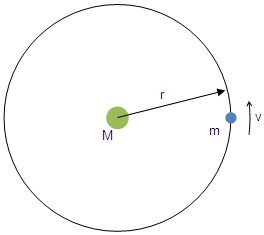First we need to consider a reference point. Here on Earth, it is tempting to consider being at rest on the ground to be the zero orbital energy point. But that means for flight between different planets we have different references to consider and that won't do. The solution is to consider the reference point to be stationary at an infinite distance from the central body, where the gravitational field is zero. Then we can use this reference for flight between as many different bodies as we wish.
Kinetic energy is easy, and from high school physics I remember it is given by
Ek = ½mV²
But from our equation [1] we found that in a circular orbit,
VC² = GM/r
So in such an orbit,
Ek = ½GMm/r = GMm/2r [2]
This is an important equation and we'll call it [2]. Just take a moment to consider what this means: the kinetic energy of a body in circular orbit is proportional to the masses of the bodies, and inversely proportional to the distance between them. So as the mass of either body increases, so the kinetic energy increases. As the distance increases, so the kinetic energy decreases. This fits with equation [1] which told us that as distance increases, so orbital speed decreases.
Now gravitational energy is a little harder to understand. It is the work done by gravity to bring a body from infinite distance to a radius r from the central body. At each step along the way, the gravity from the central body applies a force of GMm/r². At each step dr along the way from infinity to r, the work done is the force GMm/r² multiplied by the distance dr. And we add all those steps together by integrating the force from infinity to r as follows:
If calculus puts you off, feel free to take my word for it and skip to equation [3]
Eg = ∫∞r GMm/r² dr
= GMm ∫∞r 1/r²
= GMm [-1/r]∞r
= -GMm [ (1/r) - (1/∞) ]
= -GMm [ (1/r) - 0 ]
Eg = -GMm/r [3] <= equation [3]
This too is an important equation and we'll call it [3]. Just take a moment to consider what this means: the gravitational energy of a body in circular orbit is proportional to the masses of the bodies, and inversely proportional to the distance between them. But it has a minus sign, I hear you say. Yes indeed, and that means that gravitational energy increases (becomes less negative) as an object is lifted away from the central body. That fits with the idea that energy is required to do work in lifting the object. It also has some convenient consequences for orbital mechanics which we'll see later on.
Now that was the hardest piece of maths we'll do in this series, and there is no further calculus at all! Whether you followed the integration or skipped it, please go back and make sure you understand these two energies because they lay the foundation for truly understanding orbits, and all kinds of interplanetary travel.
To wrap up orbital energy, we'll add kinetic energy and gravitational energy together into a single value.
Eo = Ek + Eg
= GMm/2r - GMm/r
Eo = -GMm/2r [4]
Notice that orbital energy is negative, and increases in value as radius increases. It's as though this energy represents how far the body is located down into the gravity well of the central body. And if you imagine raising this energy past zero to a positive value as representing the orbiting body climbing out of the gravity well, then this will lead nicely on to the concept of escape velocity which we'll cover next time.
To wrap up orbital energy, we'll add kinetic energy and gravitational energy together into a single value.
Eo = Ek + Eg
= GMm/2r - GMm/r
Eo = -GMm/2r [4]
Notice that orbital energy is negative, and increases in value as radius increases. It's as though this energy represents how far the body is located down into the gravity well of the central body. And if you imagine raising this energy past zero to a positive value as representing the orbiting body climbing out of the gravity well, then this will lead nicely on to the concept of escape velocity which we'll cover next time.
That's enough for this post. Next time we'll consider how energy oscillates between kinetic and gravitational energies in elliptical orbits, and look at escape velocity.




